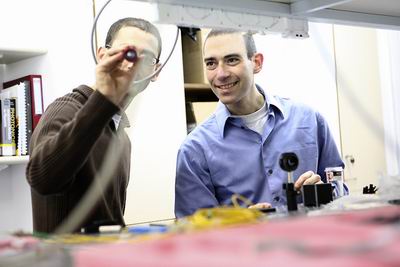A group of researchers led by Dr. Kobi Shuyer, head of the nanophotonics group at the School of Engineering, managed to transmit encryption keys in an optical fiber without the distance limit

Today it is impossible to describe our lives without the Internet and above all without the ability to make financial transfers with a reasonable degree of security. Encryption systems are an essential commodity in this day and age but this field has always been used as a tool in a mind game between the developers and the hackers who covet our credit card information. Researchers at Tel Aviv University led by Dr. Kobi Shoyer, the nanophotonics group at the School of Engineering have developed a method, which they also registered a patent for, to create an encryption key on optical fibers, while coordinating the creation of the keys between the two parties without them being exposed, and without distance limitations . The study was published at the CLEO conference and submitted for publication in "Physical Review Letters".
According to Dr. Kobi Shuyer, head of the group, the main problem with the existing methods is how to transfer the encryption key, so that only after the encryption is done, the recipient on the other side can read the content of the message. The method commonly used today is to generate the key encryption key by multiplying two very long prime numbers and factoring them back. The researchers are forced to use longer and longer numbers (with over a thousand digits), to avoid revealing these numbers, and in the end even encryptions that they thought would take a long time to crack, have already been cracked.
Another method is the quantum encryption method that makes use of the features of quantum mechanics, which allow both parties to create a key and make sure that no one peeked at the information along the way, and if they did, it is possible to estimate how much of the key has been revealed. "The method looks wonderful, apparently allows you to create a key and it is completely safe and allows you to discover hacks. In practice, on the other hand, there are some problems, explains Dr. Shoyer, the process requires technologies that do not exist and for those that already exist, the encryption key cannot be transferred to a distance of more than 150 km.
To solve the problem, the researchers came up with a simple idea: they used a completely normal optical fiber, of the type that is in commercial use, but instead of placing a transmitter on one side and a receiver on the other, they created a very long laser spread between the two sides. Two mirrors were placed on each side, each of which reflects light at a different wavelength. One wavelength represents bit 0 and the other wavelength represents bit 1. Each of the users chooses one of the mirrors at random and connects them to the laser. If both parties chose the same bit - for example 1, the laser will develop light of a certain color, if both parties chose 0, the light will get a different color, and if everyone chose a different bit, darkness will result. In this situation, the eavesdropper will be able to understand that the two parties have chosen different bits, but will not be able to know which bits, and thus an encryption key is actually obtained because, unlike the listener to the eavesdropper, each of the parties knows what he has chosen and therefore knows that the other party has chosen the reversed bits. You can perform the exercise in dozens of different wavelengths and receive dozens of encrypted bits at the same time.
Ofer Kotlitsky, a master's degree student in Dr. Shoyer's laboratory, was able to transmit a key using this method on a normal commercial fiber 200 kilometers long, while according to Dr. Shoyer, there is no limit in principle to the length of the fiber, and that it can pass through the normal amplifiers that amplify at any A few tens of kilometers the optical data that come to overcome the problem that every hundred kilometers, only a thousandth of the light that enters the optical fiber at the source reaches its destination. If and when the application becomes commercial, it will facilitate the traffic of encrypted information on the Internet (eg financial transactions), making transactions between banks, security applications and more. According to Dr. Shuyer, the project received funding from the Ministry of Defense, the German Israel Science Foundation and the BIRAX - Israel Britain program. In this framework, the laboratory cooperates with Aston University, which will allow the experiment to be repeated with the help of better men.

3 תגובות
As usual Bacher, you are perceptive and quick as lightning hahahahaha
This is exactly what I thought at the end of the article and here I am reading your comment supporting it!
But more than that, an end user will be able to pretend to be the real end user by connecting at some point on the line, how will they know that it is not the real one? And of course he will perform various financial operations!
Sounds simple but I didn't understand why you can't quote? Why don't I stand with one of the mirrors and check it all the time?
Simple and ingenious. But this means that now the information war will move from the information on the network to the information on the end user's computer, in order to find out what he chose. That's what trojan horses were invented for, but I guess it's already more complicated than looking at information transitions on the network. At the same time, I also assume that this obstacle will also be overcome by the dark forces. This is what the Red Queen Alice said in the Land of the Looking Glass: We must run as fast as possible in order to succeed in staying in place.
Greetings friends,
Ami Bachar